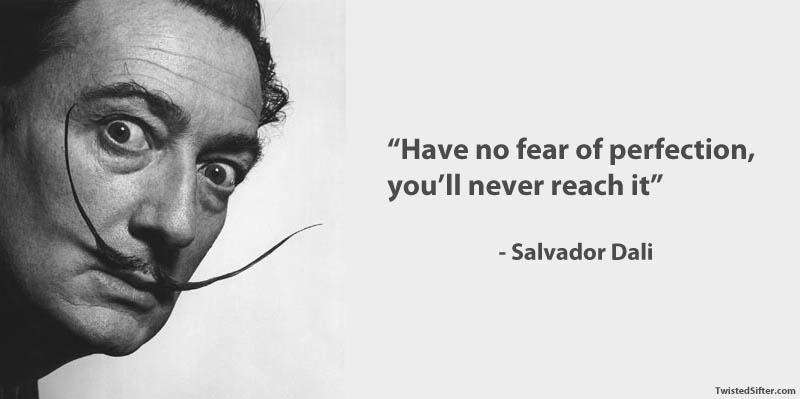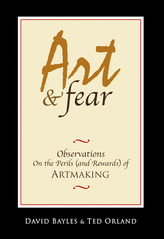"A child paints without FEAR"

Many artists have all come to blows with FEAR. We have fear of a blank canvas. We have fear at a point in our artistic creation if we should continue or stay where we are. Safe.
We become scared that we have reached a point where (If we continue) we will ruin what we have already achieved.
Digital art however allows the creator to overcome this huge obstacle by saving the image created at various point. Able to refer back and start again if all goes wrong. Traditional art does not allow for this luxury. The artist has to demonstrate conviction, strength and belief. Yes we can paint over areas we are not happy with, but FEAR is still there, ever growing.
It becomes a psychological battle to push ourselves through these times. Out of our comfort zone and into the scary unknown , all these add to the journey towards FEAR.
Bob Ross stated, "We do not make mistakes, we make happy accidents". This is a warming view yet it can be difficult to believe and attain.
We should embrace FEAR. It is not our enemy, but our guiding light into a world we never knew. It helps artists push themselves to create what they may never have thought possible.
More often artists think too much about the work they are creating and this leads at some point to fear. I think Picasso understood this and tried to escape to purity with no fear it his strokes and conviction.
A child paints without fear. They create from pure joy, innocence and are not held back from prejudgement. Maybe this is what Picasso was striving to capture in his adulthood.
Many artists stick to what they know they can achieve. It is a comfort zone and they do not wish to step further from the safety and knowledge of what they can create. Great artists are willing to push themselves and make "Happy accidents" in order to develop beyond what they initially imagined.
I think the book "Art & Fear" written by David Bayles and Ted Orland helps to answer these points.
We become scared that we have reached a point where (If we continue) we will ruin what we have already achieved.
Digital art however allows the creator to overcome this huge obstacle by saving the image created at various point. Able to refer back and start again if all goes wrong. Traditional art does not allow for this luxury. The artist has to demonstrate conviction, strength and belief. Yes we can paint over areas we are not happy with, but FEAR is still there, ever growing.
It becomes a psychological battle to push ourselves through these times. Out of our comfort zone and into the scary unknown , all these add to the journey towards FEAR.
Bob Ross stated, "We do not make mistakes, we make happy accidents". This is a warming view yet it can be difficult to believe and attain.
We should embrace FEAR. It is not our enemy, but our guiding light into a world we never knew. It helps artists push themselves to create what they may never have thought possible.
More often artists think too much about the work they are creating and this leads at some point to fear. I think Picasso understood this and tried to escape to purity with no fear it his strokes and conviction.
A child paints without fear. They create from pure joy, innocence and are not held back from prejudgement. Maybe this is what Picasso was striving to capture in his adulthood.
Many artists stick to what they know they can achieve. It is a comfort zone and they do not wish to step further from the safety and knowledge of what they can create. Great artists are willing to push themselves and make "Happy accidents" in order to develop beyond what they initially imagined.
I think the book "Art & Fear" written by David Bayles and Ted Orland helps to answer these points.

This is a book about the way art gets made, the reasons it often doesn't get made, and about the difficulties that cause so many artists to give up along the way. David Bayles and I are both working artists, grappling daily with the problems of making art in the real world — the observations we make are drawn from personal experience, and relate more to the needs of fellow artists than to the interests of viewers. --Do not mistake Art & Fear for a pop psychology self-help book — we're not interested in freeing your inner child! This is a book about what it feels like to sit down at your potter's wheel or keyboard, easel or camera, trying to do the work you need to do. What we’ve tried to do is illuminate the obstacles you face, and offer some artistic strategies for getting past them.
Art & Fear has become something of an underground classic, and has now sold over 180,000 copies by word of mouth advertising alone.
Art & Fear has become something of an underground classic, and has now sold over 180,000 copies by word of mouth advertising alone.
I personally hope to break through my fear when I paint and go on that journey of discovery. That however will be another story until next time.
PLEASE leave your views. They will help many in the future, and above all....Have no FEAR of FUN painting..
PLEASE leave your views. They will help many in the future, and above all....Have no FEAR of FUN painting..
 RSS Feed
RSS Feed

